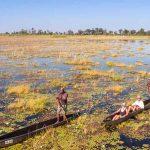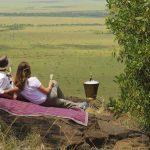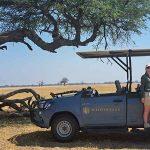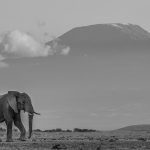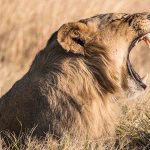Want to escape your fellow tourists on safari? Opening a five-page guide, Brian Jackman recommends a visit to the Northern Serengeti – a Masai Mara without the crowds.
Only five days before I arrived in Tanzania the Serengeti was bone-dry. The wildebeest herds had long since marched north to Kenya; and at Grumeti River Camp in the Western Corridor, the long arm of the Serengeti that reaches out towards Lake Victoria, hippos were dying for want of water.
Now the kiangazi – the dry season – is over. The November rains have broken with a vengeance and the hippos can wallow to their hearts’ content in the pools beyond my tent.
I wish I could stay longer, but Grumeti River Camp is an idyllic prelude. What I really want is to explore the secret valleys and forgotten hills of the Northern Serengeti, and an old friend has volunteered to take me there.
Paul Oliver, who comes from Norfolk, moved to Tanzania 20 years ago and is now one of the country’s most respected safari guides. We have arranged to meet at Seronera, in the heart of the park, and from there we set off in his distinctive coffee-brown, custom-built Land Rover.
“This is as far as most visitors get,” says Paul, as we head into the northern woodlands. And it’s true. Once we’ve crossed the Orangi River we do not see another vehicle until we hit camp.
It takes us seven hours to reach Paul’s private mobile safari campsite. We could have flown – there’s an airstrip nearby – but only when you travel overland does the sheer size of Africa’s most famous national park impress itself upon you.
The Kenyan border is just a few miles from camp, and in coming here I have realised a lifetime’s ambition. On the other side lies the Maasai Mara national reserve, an area as familiar to me as the Dorset hills of home. How many times have I stood there, staring down into Tanzania and longing to follow the migrating wildebeest on their long journey south?
Now here I am, on a granite hill called Wogakuria, surrounded by ancient fig trees and giant kopjes (hills) that echo to the roar of lions, and right now, with the wildebeest all around us, there is nowhere else I would rather be.
No wonder Myles Turner, last of the old-time Serengeti wardens, loved this place. Wogakuria is the highest point for miles around, and what you get from its boulder-strewn slopes is a vulture’s eye-view, an immense panorama of yellow plains, mapped with the green veins of seasonal watercourses and speckled with grazing herds of game.
From our campsite I can look deep into the Mara. At night the lights of Keekorok Safari Lodge glitter in the darkness, some 40 miles away; and next morning I can see the hot-air balloons rising from Little Governors’ Camp, and know that vehicles by the score will be fanning out over the reserve in search of big cats. But, on our side of the border, we have it all to ourselves.
Off-track driving is still allowed in the north, and over the next two days we explore the maze of nameless valleys around Wogakuria. The gift of rain has renewed the land and, wherever we go, there is life.
This is paradise found. It’s like the Maasai Mara I knew 30 years ago, with animals as far as the eye can see, and huge river crossings when the migration is passing through. You can spend a whole day, as I did, in which the only other vehicle we saw was a national park Land Rover full of armed rangers in green combat fatigues.
How could this idyllic corner of the Serengeti have been overlooked for so long?
To find out you have only to drive past the Fort Knox-style guard post at Kogatende on the Mara River. Until a couple of years ago this was bandit country, with heavily armed poaching gangs swarming down from the Isuria escarpment to prey on wildlife and tourists alike. Now, the worst of the poachers have fled. Their campfires are cold and the north is safe again for visitors.
The Tanzanians are keen to attract more tourists but, at present, the only other camp in the north-west is Sayari, overlooking the Mara River. Like Paul’s hideaway at Wogakuria it is a seasonal camp with eight spacious tents, each with king-size beds and en-suite showers, offering standards of luxury unknown in Myles Turner’s days.
From Sayari it is only a short drive into the Lamai Wedge, a sublime sweep of rolling savannah between the Mara River and the Kenyan border. The contrast with the rock-strewn hillsides and fig-tree groves of Wogakuria could not be greater. Here, the land is open to the sky, an endless sea of grass in which Thomson’s gazelles race this way and that, like shoals of fish. The wind carries the sounds of the plains, the sad cries of pipits, the shriek of crowned plovers, and to the north lies a range of enigmatic flat-topped hills, marking the border with the Maasai Mara.
Steadily we climb towards them, scouring the grasslands for cheetahs. There are lions aplenty, resting in the croton thickets and on the long stony ridges where they can catch the breeze.
But the cheetahs Paul saw a week ago have moved on in the wake of the wildebeest herds, leaving only the slouching shapes of spotted hyenas and the remains of old kills picked clean by vultures.
It’s a shame to have missed out on the cheetahs but I have one last chance to find them. After four blissful days in the north-west, Paul drops me off at Klein’s Camp, a private 24,800-acre game reserve on the park’s north-east boundary.
This is luxury camping in a wild land. My tent – marquee would be a better word – is furnished with Persian rugs and lit by crystal chandeliers. The food is unfailingly delicious and I have even been given my own butler, Ben, a soft-spoken paragon with impeccable manners, who brings my early-morning tea.
But, as always on a good safari, the greatest luxury is a good location, and ours, overlooking a hidden valley in the Kuka Hills, is Hemingway’s Africa at its best. Cape buffaloes scowl from its thorny thickets and it’s a long time since I have encountered such feisty lions.
On one game drive we track down a coalition of five young males, fired up with testosterone and looking for trouble. One, a wild-looking tearaway with an ASBO attitude, decides to stalk our vehicle and then chase us as we drive away.
On we go in the last hour of daylight and it is then, with the Kuka Hills already in shadow, that we find a cheetah on the plains and watch her methodically sniff out a topi fawn in the long grass while its mother stands helpless nearby.
Back at camp, I hear there is a pack of 18 wild dogs in the hills of Loliondo, just outside the park, and Daniel knows a tracker who will take me to their den next morning.
Loliondo is Maasai country, and we drive for miles past thornbush stockades and red-robed herd-boys with flocks of goats until we reach a range of hills. From here, it’s a 40-minute hike to the den.
We climb steadily, without talking. The tracker’s “thousand-miler” sandals, cut from the treads of discarded car tyres, make no sound on the wooded slopes. He is armed only with a spear.
From the bushes up ahead comes a gruff bark. The tracker points, and there are the dogs. With their big round ears they are unmistakable and their brindled coats blend perfectly with the dappled shade. No wonder their Swahili name is mbwa mwitu: the dogs of the forest.
There are only three, left behind to guard the den while the rest of the pack is hunting, and no sign of the pups, but I don’t care. Wild dogs are a vanishing species. It is 25 years since I last saw them in East Africa, and to know they are still here is hugely encouraging. For a few precious moments we sit and watch them. By now they have become accustomed to our presence, and lie quietly at the entrance to the den while from all around come the throbbing cries of Cape turtledoves.
Whenever I think of the Serengeti it is always the big cats that spring to mind and this safari has been no different. In just 10 days I have seen two cheetahs and nearly 60 lions. But long after I have returned home it is the image of those three dogs that haunts me, as wild and mysterious as Africa itself.

